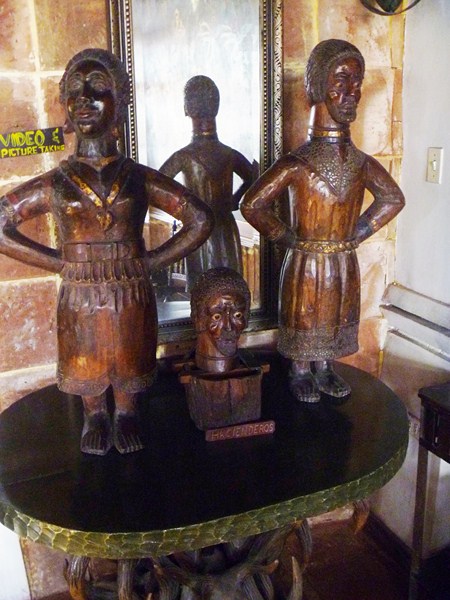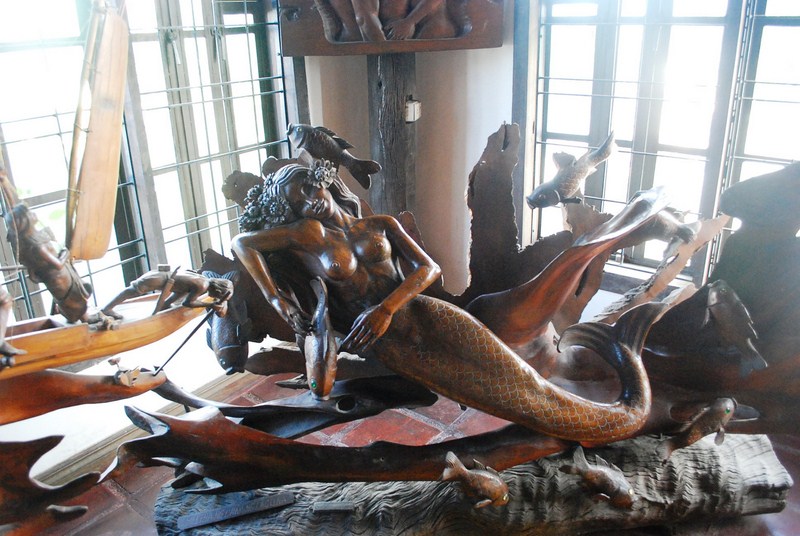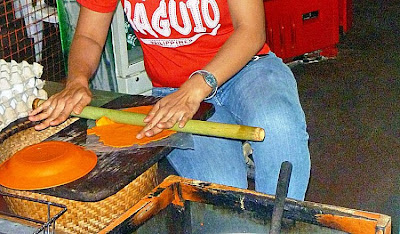After my interview with Nemi R. Miranda, Jandy and I moved next door to the Balaw-Balaw Specialty Restaurant. This restaurant, made famous by Andrew Zimmern in Discovery Travel and Living’s “Bizarre Foods,” offers truly exotic cuisine such as sautéed ants and crickets, wood worms and frog cooked adobo style, Soup No. 5 (cow butt and testicles), adobong uok (beetle larvae), among others.
Andrew tried the last two. However, having already taken lunch, we weren’t there for the exotic food (Maybe next time). Rather, we wanted to explore the Ang Nuno Artists Foundation Gallery at the second floor.
Luckily, Andre, the restaurant manager (and also an artist) son of the late artist and sculptor Perdigon N. Vocalan, was there and he granted us permission to explore the gallery upstairs. The dining area is already a gallery of sorts, with colorful paper mache sculptures and paintings (with subjects ranging from basket of fruits to mythical creatures) all around the patchwork property. Outside, soda bottle lanterns hang from trees.
Upon climbing the spiral staircase, we were ushered into an impressive repository of Philippine treasures that showcases Filipino heritage through colorful papier mache, antiques and artworks by Perdigon, his sons Andre and Rembrandt as well as other independent and budding local artists and craftsmen from Angono and other Rizal towns.
| A collection of wood sculpture and furniture |
The accomplished Vocalan was influenced by the late National Artist and Angonon Carlos “Botong” Francisco (November 4, 1912 – March 31, 1969) and his various paintings, sculptures and woodcarvings, inspired by Filipino traditions and legends,capture Angono’s rich cultural heritage as well as depict folk stories and characters like the kapre (a menacing creature that seeks refuge in big trees), duwende (goblin), tikbalang (demon horse), manananggal (a woman with the ability to detach the two halves of its body at the waist), and the like. He also depicted women in all their glory and beauty. There are also several depictions of the Mother and Child.
 |
| Dining table with tapayan above it |
The gallery, a reflection of Perdigon’s eclectic taste, also has an impressive collection of antiques and religious objects such as statues of saints (some just heads without a body), a complete tableau of the Last Supper and a Santo Entierro (statue of the dead Christ). There’s also a collection of antique furniture including folding chairs, a complete dining table set (with earthen, knee-tall jars or tapayans hanging above it) and a huge, intricately carved wooden door.
 |
| Tableau of Last Supper |
I also took a peek, via a spiral stairway, at the third floor which houses a workshop where huge, colorful masks of the higantes for the Higantes Festival are made. In 1987, Perdigon conceived the idea of the Higantes Festival.
He advocated having more higantes (papier mache giants) in the town fiesta by coordinating with the barangays of Angono to come up with higantes that will represent their barangay. Miniature papier mache dolls, great examples of Filipino folk art, are also made here for souvenir hunters.


















.jpg)
.jpg)